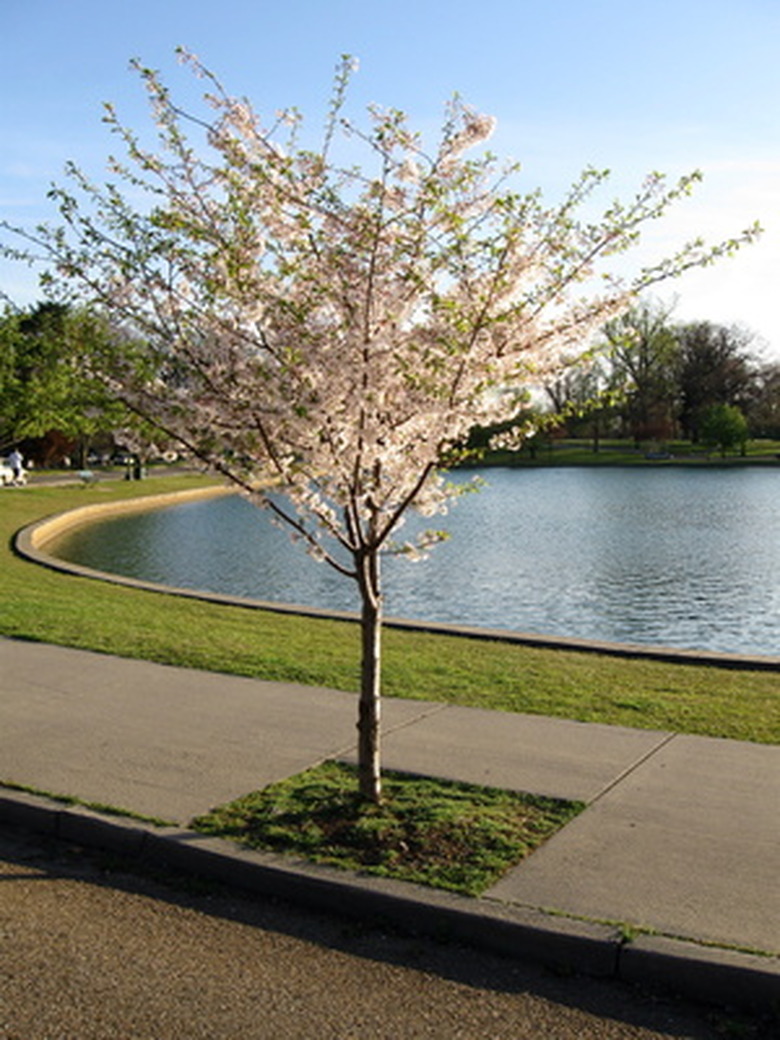Dogwood Vs. Bradford Pear
Homeowners value both Bradford pears and dogwoods as medium-sized ornamental trees offering spring blossoms, summer shade, spectacular fall color and fruit for birds. Bradford pears are a specific cultivar of the ornamental Callery pear tree, while dogwoods encompass an entire species of trees and shrubs. The variety known as flowering dogwood is commonly used in landscaping.
Descriptions
Bradford pears generally reach about 40 feet tall and wide. The branches usually grow upright rather than horizontally. The tree bears white 1-inch flowers in April or May and half-inch inedible greenish round fruit in the summer. The leaves turn a variety of striking colors in the fall, from yellow to purple.
- Homeowners value both Bradford pears and dogwoods as medium-sized ornamental trees offering spring blossoms, summer shade, spectacular fall color and fruit for birds.
- The variety known as flowering dogwood is commonly used in landscaping.
Flowering dogwoods grow between 20 and 35 feet and about as wide. Shade-grown dogwoods grow taller and wider than those in full sun. The trees blossom with 3-inch white, pink or yellow flowers in early spring, depending on the cultivar. Its small red berries grow in clusters. The tree bursts into red or maroon color when fall arrives.
Bradford Pear Disadvantages
Bradford pear's closely spaced, vertical branches make them vulnerable to ice storms, especially after they reach about 20 years of age. Pruning helps reduce potential damage, but leads to other problems, according to the University of Florida Extension. "Even following pruning by a skilled crew, trees often look misshapen with most of the lower foliage removed and the lower portions of the multiple trunks showing," the extension service says. In addition, the flowers of Bradford pear, while lovely, yield a fragrance that Clemson University horticulturalist Bob Polomski refers to as "sweaty socks."
- Flowering dogwoods grow between 20 and 35 feet and about as wide.
- The trees blossom with 3-inch white, pink or yellow flowers in early spring, depending on the cultivar.
Flowering Dogwood Disadvantages
Flowering dogwood lacks the specific drawbacks of the Bradford pear, but is a bit fussier about soil conditions and planting placement than Bradford pear trees. In the wild, dogwoods grow as "understory" trees, relying on afternoon shade from larger trees. Left alone in the middle of a lawn, the shallow-rooted trees sometimes fall prey to lawn herbicides. Dogwoods are also more dependent on consistent watering than Bradford pear trees are. Dogwoods as a group suffer more from disease and pest infestations than the sturdier Bradford pear.
Origins
For North American gardeners interested in focusing on native plants, flowering dogwoods have the edge over ornamental pears. Cornus florida is native to the eastern part of the U.S. Bradford pear originated in China. The species from which it was bred, Pyrus calleryana, is native to China and Korea. It was brought to the states in 1919 from Nanking, China, and entered the garden mainstream in the 1960s.
- Flowering dogwood lacks the specific drawbacks of the Bradford pear, but is a bit fussier about soil conditions and planting placement than Bradford pear trees.
Uses
Both Bradford pear and flowering dogwood make useful shade trees. They also herald spring with a burst of showy blossoms, and erupt in rich foliage color at the beginning of fall. While neither offers fruit suitable for human consumption, birds are attracted to both Bradford pears and flowering dogwood berries.
Alternatives
Gardeners wary of Bradford pear's vulnerability to winter storms may wish to choose the more modern ornamental pear cultivar 'Cleveland Select,' bred to have a sturdier growing habit. Homeowners interested in edible landscaping may choose the Kousa dogwood rather than the flowering dogwood. Kousas possess flowering dogwood's ornamental charms but also produce raspberry-like fruits excellent in jams and jellies.
